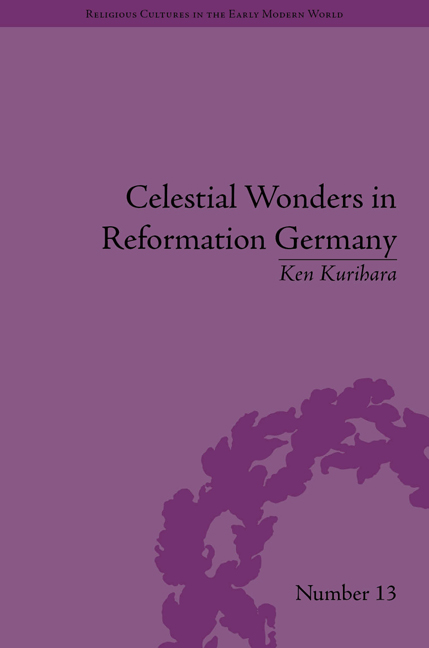Book contents
- Frontmatter
- CONTENTS
- Acknowledgements
- List of Figures
- Introduction: Celestial Wonders, Confessional Conflicts and Apocalypticism
- 1 Exploring the World of Wunderzeichen
- 2 Lutheran Clergy and Wunderzeichen Discourses
- 3 ‘An Eagle Hurting Himself’: Flacius's Tract against the Interim
- 4 Irenaeus against ‘Spiritual Wolves’: Polemical Use of Wunderzeichen, I
- 5 Irenaeus against the Concord: Polemical Use of Wunderzeichen, II
- 6 Andreae's Pastoral Use of Wunderzeichen
- 7 Celestial Wonders under the Shadow of War
- Conclusion
- Notes
- Works Cited
- Index
1 - Exploring the World of Wunderzeichen
- Frontmatter
- CONTENTS
- Acknowledgements
- List of Figures
- Introduction: Celestial Wonders, Confessional Conflicts and Apocalypticism
- 1 Exploring the World of Wunderzeichen
- 2 Lutheran Clergy and Wunderzeichen Discourses
- 3 ‘An Eagle Hurting Himself’: Flacius's Tract against the Interim
- 4 Irenaeus against ‘Spiritual Wolves’: Polemical Use of Wunderzeichen, I
- 5 Irenaeus against the Concord: Polemical Use of Wunderzeichen, II
- 6 Andreae's Pastoral Use of Wunderzeichen
- 7 Celestial Wonders under the Shadow of War
- Conclusion
- Notes
- Works Cited
- Index
Summary
The Mansfeld Chronicle (1572), compiled by the Mansfeld deacon Cyriakus Spangenberg, vividly depicts the difficult environment people had to confront while living in the ‘Little Ice Age’. Deterioration of climatic conditions, severe storms, repeated floods, inflation, pestilence and fatal accidents regularly appear in the entries. As though putting lively accents into this gloomy narrative, Spangenberg inserts stories of wondrous incidents that occurred in the region. These include reports of misbirths, divine punishments on disbelievers and a mysterious spectre seen in the mountains, but the predominant types of wonder are celestial wonders: ‘People saw the three suns’ ‘some people … saw a cross in the sky, followed by a hand holding two Turkish sables’ ‘some say that people saw two blood-red men in the sky’ ‘in many places in the land of Sachsen, the nightly sky was seen … as if it is really burning ’ ‘a blood-red beam was seen … After that a cloud stood in the sky, [which looks] like a bier for the dead with a white cloth and black cross’. Such entries frequently appear in the pages. Why did the prominent clergy of the city show such an interest in these phenomena? How did Spangenberg and his readers interpret these incidents? Some of the wondrous phenomena recorded in the chronicle took place in distant lands such as Lübeck – how did Spangenberg obtain information about such incidents?
- Type
- Chapter
- Information
- Celestial Wonders in Reformation Germany , pp. 13 - 36Publisher: Pickering & ChattoFirst published in: 2014



